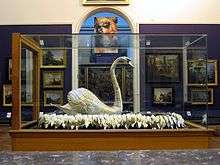Silver Swan (automaton)


The Silver Swan is an automaton dating from the 18th Century and is housed in the Bowes Museum, Barnard Castle, Teesdale, County Durham, England. It was acquired by John Bowes, the museum's founder from a Parisian jeweler in 1872.[1]
The swan, which is life size, is a clockwork driven device that includes a music box. The swan sits in a "stream" that is made of glass rods and is surrounded by silver leaves. Small silver fish can be seen "swimming" in the stream.[2]
When the clockwork is wound the music box plays and the glass rods rotate giving the illusion of flowing water. The swan turns its head from side to side and also preens itself. After a few moments the swan notices the swimming fish and bends down to catch and eat one. The swan's head then returns to the upright position and the performance, which has lasted about 32 seconds, is over. To help preserve the mechanism the swan is only operated once each day at 2pm.[2]
The mechanism was designed and built by John Joseph Merlin (1735-1803) in conjunction with the London inventor James Cox (1723–1800) in 1773.[1]
The swan was described in a 1773 United Kingdom Act of Parliament as being 3 feet (0.91 m) in diameter and 18 feet (5.49 m) high. This would seem to indicate that at one time there was more to the swan than remains today as it is no longer that high. It is said that there was originally a waterfall behind the swan, which was stolen while it was on tour – this could possibly explain the height which is now 'missing'.[2]
It is known that the swan was sold several times and was shown at the World's Fair (Exposition Universelle (1867)) held in Paris, France. The American novelist Mark Twain observed the swan and recorded his observation in a chapter of the Innocents Abroad,[2] writing that the swan "had a living grace about his movement and a living intelligence in his eyes.[1]"
The Bowes Museum believes that the Swan is their best known artefact, and it is the basis of the museum's logo.[2]
Notes
- 1 2 3 Holledge, Richard (21 December 2012). "Magic Wrought by a Merlin". Wall Street Journal. Retrieved 19 October 2014.
- 1 2 3 4 5 The Silver Swan, description on a website of the Bowes Museum (archive at the Internet Archive -- originally retrieved 2011-8-15)
References and further reading
- T. P. Camerer-Cuss: The Silver Swan. Antiquarian Horology 4 (Juni 1965), pp. 330–34
External links
| Wikimedia Commons has media related to Silver Swan (automaton). |
- The Silver Swan, description on a website of the Bowes Museum
- Silver Swan, photos and a description on an educational site
- video of the silver swan in motion
Coordinates: 54°32′31″N 1°54′55″W / 54.54194°N 1.91528°W